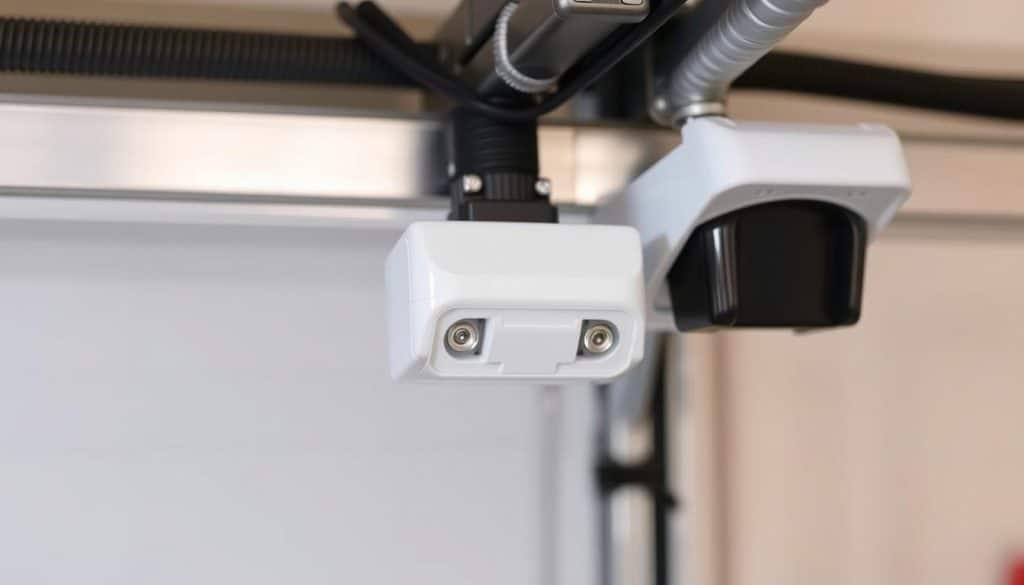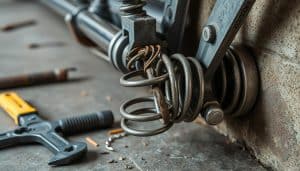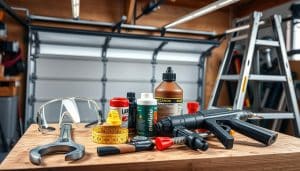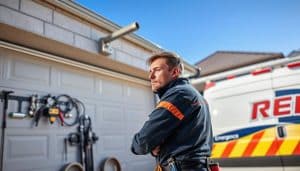Ever found yourself stuck when your garage door won’t open? Knowing why this happens can save you time and money. We’ll look at what are the common reasons a garage door won’t open and how to fix it.
Power loss is a big reason for garage door problems. A locked door can also stop the opener from working. If the door and trolley get disconnected, the motor will run but the door won’t move.
Garage doors have safety sensors to prevent accidents. A humming noise means the capacitor might be failing. Issues like rollers coming off tracks or broken springs can also stop your door.
Key Takeaways
- The most common reason for a garage door not opening is loss of power.
- Locking the garage door can prevent the opener from functioning.
- Photo eye safety sensors are critical in preventing door movement when obstructed.
- Regular maintenance can reduce the likelihood of malfunctions by up to 40%.
- Broken springs or cables account for approximately 25% of malfunction issues.
Understanding Garage Door Mechanisms
Garage doors work thanks to complex mechanisms that use many parts. Knowing how these systems work helps us fix problems that stop them from working right. The opener is key, using chain, belt, or screw drives. Each has its own benefits for how well it works and how long it lasts.
How Garage Doors Function
Garage doors use a system of tracks, rollers, and springs to move. If something goes wrong, knowing what parts do their job helps us find and fix the issue. For example, torsion springs lift the door, and safety sensors prevent accidents. Keeping these parts in good shape is important for the door to work right.
Key Components to Consider
It’s important to check rollers, springs, and the opener often. Worn-out rollers can make the door hard to move. Springs need to be replaced after a few years because they wear out. Knowing this helps keep your garage door safe and working well.
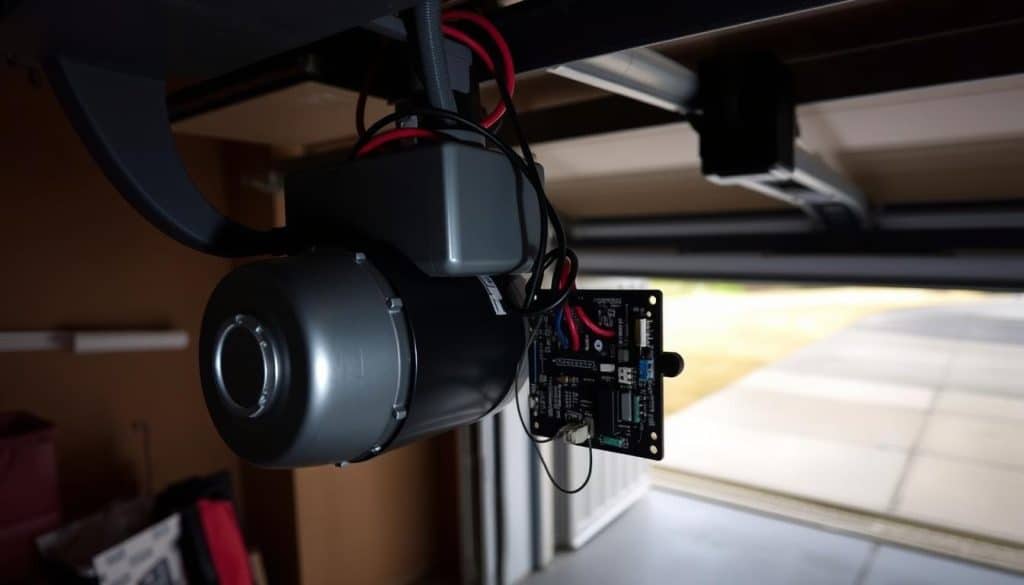
Power Issues with Your Garage Door
Power problems are a big reason why garage doors won’t open. About 30% of garage door opener issues come from power source problems. First, check if the opener is plugged in and look for any other power issues.
A lack of power shows up when the remote and wall switch don’t work. This tells us where to go next.
Checking the Power Source
First, we need to check the power source of the garage door. Make sure the opener is plugged in correctly. Then, check if there are any power outages in your area.
If everything looks good outside, inspect the electrical connections. About 15% of power problems come from loose or corroded connections. Cleaning and tightening these can fix the issue.
Circuit Breaker and Fuses
Next, check the circuit breaker and fuses that power the garage door. A tripped circuit breaker can stop the garage door from working. This often means there’s a bigger electrical problem.
Resetting the circuit breaker might solve the problem. But if it trips again, it could mean a bigger issue with your home’s electrical system.
Remote Control Problems
Having trouble with a remote control garage door is common. It often comes from simple issues like dead batteries or signal problems. If your garage door works with the wall switch but not the remote, try changing the batteries first. These batteries usually last about two years, and forgetting to check them can cause a lot of hassle.
Battery Replacement Tips
When your remote won’t work, the first thing to do is check the batteries. Many people forget this, leading to about 70% of remote issues being battery-related. It’s best to replace the batteries every two years and keep the remote in a stable place. This can prevent many problems. Also, fixing programming errors can help a lot; many issues come from these mistakes.
Signal Interference
Signal interference can really mess up your garage door remote. Garage door openers usually work in the 300MHz to 390MHz range. This means other devices at the same frequency can cause problems. Studies show that nearly 45% of remote issues are due to interference, often from nearby appliances. Checking the area where you use the remote can help find and fix interference problems. By tackling these issues, we can make our remote control garage door work better.
Garage Door Opener Malfunctions
Knowing when your garage door opener is acting up is important. It helps us catch problems early and avoid bigger issues. Look out for strange noises or if the door won’t move. A humming sound means it’s trying to start, even if it doesn’t.
Spotting these signs is critical for quick action.
Signs of a Failing Opener
Strange noises or the opener cycling without moving are red flags. If the motor has trouble, it could mean the motor capacitor is failing. Torsion springs under too much tension might also break, stopping the door.
Fixing these issues quickly can save us from more damage and expensive replacements.
When to Replace Your Opener
Deciding when to replace a garage door opener involves several factors. If it’s several years old, nearing the 20 to 30 year mark, it might need to be replaced. Trying to fix it, like adjusting limit switches or remotes, might mean it’s time for a new one.

Obstructions in the Door Tracks
Garage door obstructions can stop the door from opening or closing. Things like leaves, dirt, small kids, or pets can get in the way. Checking for these blockages only takes a few minutes but is very important.
By looking for these obstructions, we keep your garage door safe and working well.
Detecting Blockages
It’s important to find any garage door obstructions. We need to clean the tracks from dirt or grime. Also, checking if the hardware is aligned is key.
Sensors help detect objects in the door’s path. A detailed check helps avoid problems and keeps your garage safe.
Importance of Regular Maintenance
Regular maintenance of the door tracks helps your garage last longer. We check everything regularly to avoid surprises. This way, we stop common problems that could make the garage door break.
About 30% of garage door problems come from track obstructions. Keeping up with maintenance makes sure your garage door works well and keeps you safe.
Sensor Misalignment
It’s important to know how garage door safety sensors work. They help keep your garage safe by spotting obstacles. If the sensors blink red, it means they’re not working right.
This can happen for many reasons. It might be because of bumps, humidity, or dirt. These things can mess with the sensors.
Understanding Safety Sensors
Safety sensors are key to avoiding injuries and damage. They’ve been a must in garage doors for over 25 years. But, they can go wrong if not checked often.
Most garage door problems come from misaligned sensors. Cleaning the lenses every few months helps keep them working well. This stops dirt from blocking their view.
How to Re-align Your Sensors
Fixing misaligned sensors is easy and quick. If the lights flash orange, it might mean the wiring is damaged. Checking and adjusting the sensors regularly can prevent many problems.
Just a little tweak can fix most issues. This is even more important in places where things get knocked around a lot. Regular checks can save you from expensive fixes and keep your garage door running smoothly.
Damaged or Worn Parts
Keeping our garage doors in good shape means watching for wear on parts. Over time, these parts can wear down, which can be dangerous. Regular checks help prevent bigger problems later.
Identifying Dangerous Wear and Tear
It’s important to spot damage in key parts like springs, rollers, and cables. Unusual sounds, like grinding, can mean tracks need oil. Ignoring these signs can cause big problems or even harm.
The Importance of Routine Inspections
Regular checks are key to keeping garage doors safe and working well. Studies show that looking after them can cut repair needs by half. By keeping up with maintenance, we avoid costly fixes and feel secure.
Weather-Related Challenges
Weather can greatly affect garage door functionality, more so in winter. Temperature impacts often cause garage door issues. Cold weather can make lubricants thick and even freeze, leading to slow door movement.
Also, metal parts contract in cold, making the door harder to open. This shows why regular maintenance is key.
Impact of Temperature Changes
Temperature changes affect garage door performance. Cold weather can solidify greases, causing friction and jamming. Frozen doors often result from moisture that freezes in cold temperatures.
Studies show 30% of garage door malfunctions happen in cold weather. Older doors are more prone to winter issues. Regular maintenance is vital to avoid problems.
Solutions for Extreme Weather
Using weather-resistant lubricants can help garage doors perform better all year. We suggest lubricating doors at least once a month in winter. This keeps them running smoothly.
Also, check and replace weather stripping to keep cold air out. Clearing ice from door tracks prevents operational issues. Regular maintenance can reduce winter garage door problems.
Manual Release Mechanism Issues
The manual release mechanism is key for garage door use, even when power is out. Knowing how to use it helps us switch between electric and manual modes easily. If it doesn’t work right, we might think there’s a bigger problem.
Understanding Manual Operation
Using the manual release lets us open the garage door by hand when needed. It’s important to know how to do this right. If it’s not working, it could be because of dirt or broken parts. We need to keep it clean and working well.
How It Affects Door Functionality
Problems with the manual release can mean bigger issues with the garage door opener. Studies show up to 30% of garage door problems are with the opener. If the door is hard to open by hand, it might need fixing.
We should check it regularly and know how it affects the door’s performance. This way, we can fix any problems early on.
Seek Professional Help
Many garage door problems seem simple but can be complex. DIY troubleshooting might not be worth the risks. Issues with springs and electrical parts can be dangerous.
Broken springs can cause doors to fail and create a lot of force. Getting professional help is safer and more reliable.
Why DIY Isn’t Always the Answer
Trying to fix garage doors without the right knowledge can be risky. Snapped cables can make doors move unevenly, a common DIY mistake. About 30% of problems come from misalignment or wear.
More than 50% of service calls are about noise, often from parts that aren’t well-lubricated or adjusted. Regular checks and adjustments are key. Complex problems usually need more than DIY skills.
The Benefits of Working with Experts
Experts make repairs safer and ensure quality. They handle risks from broken springs or faulty wiring. About 40% of problems need expert help after DIY fixes fail.
Professionals can spot issues like electrical failures or sensor problems quickly. This approach saves money and prevents future problems. It keeps your garage door working well and safely.
Why Choose Emerald Garage Door Services?
Emerald Garage Door Services is a family-owned business in Orlando, FL. We’re all about top-notch service. Our founder, James Balfe, makes sure every job is done right. We back our work with a guarantee, including parts and labor.
Our Commitment to Quality and Integrity
Homeowners often face challenges with garage door maintenance and repair. Issues like broken springs and misaligned tracks can be a big problem. Our team is ready to handle any issue, from routine checks to urgent repairs.
We aim to keep your garage door working well. This can save you money in the long run.
How We Stand Out in Orlando, FL
We’re known for quick service in Orlando. Our customer satisfaction rate is over 90%. We’re here to fix your garage door problems fast.
Our team doesn’t just fix your door. We also make sure it lasts longer with regular checks. Choose Emerald Garage Door Services for a secure and functional home.
